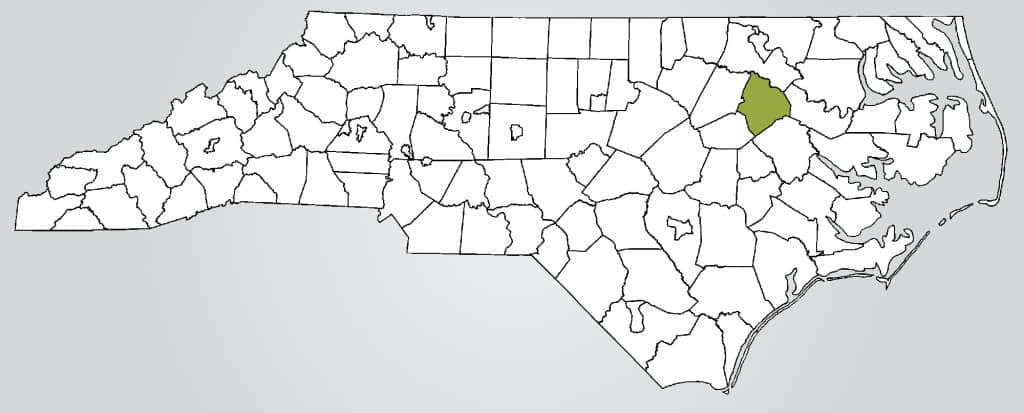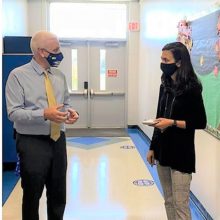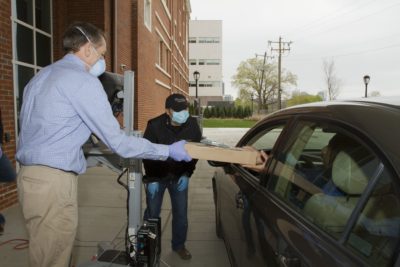
Shawna Andrews grew up in Edgecombe County and spent the majority of her career in various roles with Edgecombe County Public Schools, where she now works as director of middle school programs and Title I. About a year ago, her family moved from the town of Tarboro — the county seat with a population of roughly 11,000 — to a rural area about 10 miles outside of town on the north side of the county.
“I did not realize before I moved that we were going to have this many issues with internet,” said Andrews, whose mother lives a few miles down the road and has no problem connecting to the internet.
Andrews put it quite simply when she described her home as being “right in the middle of nowhere.” And for her and the many other North Carolinians who find themselves with few or no internet options — whether that be due to geographic location, cost, or other barriers — the shift to remote working and learning during the COVID-19 pandemic presents a great challenge.

When unlimited data isn’t enough
The only way Andrews can access the internet from home is by using the mobile hot spot on her cell phone. She uses that for work-related tasks, but decided to purchase an additional hot spot through her mobile carrier for the whole family to use. Andrews pays a premium for that hot spot to come with unlimited data — but it’s not that simple.
Once Andrews and her family use 15 gigabytes of data, which generally takes about a week or so, the internet speed slows down to “basically nothing,” and if more than one device is online at a time, they “all basically get kicked off.”
“Even though you have unlimited data, it really doesn’t mean you have high-speed,” said Andrews. “Having a 12-year-old who enjoys gaming, you can imagine how long those 15 gigabytes last.”
Andrews sees how this limited access to the internet impacts her son, Aiden, whose ability to both engage in remote learning and digitally connect with his friends during COVID-19 is limited. And the hot spots don’t provide an affordable solution, either.
“Our phone bill is outrageous because we have to have the unlimited data plan and the hot spot. So we’re paying a fortune for what we get,” said Andrews.
Edgecombe County, North Carolina
Data source: NC Department of Information Technology Broadband Indices, which pulled the following variables from the U.S. Census Bureau’s 2013-2017 American Community Survey.
– Broadband subscription rate (households with a DSL, cable or fiber-optic subscription): 46.21%
– Households with no internet access: 37.4%
– Households with no computer devices: 27.6%
The other options
The only other provider Andrews knows of in her area is a satellite-based internet service. Through conversations with neighbors who have it, Andrews decided the quality and affordability of that option was no better than what she could access through the mobile hot spot.
Then, Andrews decided to call her home phone company to see if her house could access dial-up internet through their land line. But the company said internet was not offered at her home’s location — coverage stopped at the cotton gin a few miles down the road and the creek across the street.
While drive-up Wi-Fi spots are available in some parts of the county, they aren’t located near enough to be a practical solution for Andrews and her family.
“We’re just in a dead zone area where they don’t have the infrastructure or the structure at all to provide internet service for this area,” she said.
Facing the realities of COVID-19
Gov. Roy Cooper first closed all North Carolina public schools for two weeks beginning March 16 — a closure that has since been extended through May 15. That means at least nine weeks of remote learning for students, including everyone from Andrews’ own son to her neighbors’ college-aged students who have returned home and are working to keep up with online courses.
“All of a sudden, this whole area really needs internet, and we don’t have access … we’re just doing what we have to do to survive right now,” she said.
Before the COVID-19 pandemic, the Andrews family used to visit their grandma’s house for access to the internet — an activity that has become too risky. Fortunately, Andrews’ mobile carrier added 15 extra gigabytes of data to her plan for the month, allowing her son to keep up with remote learning using his cell phone. If and when that data runs out, she’ll drive him to the parking lot of the school district offices to access Wi-Fi.
But Andrews worries about the ability of students across the district to stay connected to remote learning throughout the duration of school closures. While cell phone reception is decent at her home, Andrews said many other parts of the county lack cell phone service in addition to lacking internet access — further complicating students’ ability to learn during COVID-19.
“I just don’t think they can access as much online learning as if we had the ability to access the internet freely, and high-speed internet — not just this slow, buffering internet — but something that was reliable and high-speed,” she said.
Andrews has heard of many offers from internet providers that are running discounts and deals during COVID-19 — but she said the lack of infrastructure in her area prevents her and others from even being eligible for those services.
“Making it equitable for all is extremely important, and I don’t know if we always think about people who live in areas in which they cannot access the internet,” she said.
Look up the broadband subscription rate for your county
The following data lookup tool is populated with data from the U.S. Census Bureau’s 2013-2017 American Community Survey (ACS). Type in the name of any North Carolina county to see its broadband subscription rate, which is the percentage of households with a DSL, cable, or fiber-optic subscription.



